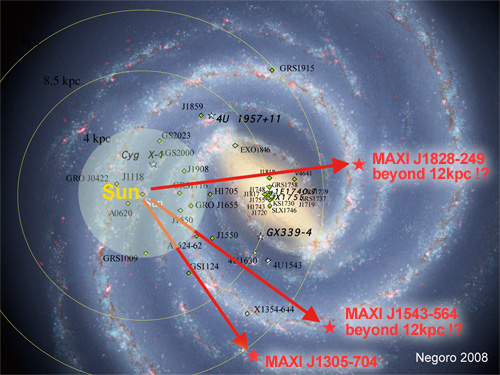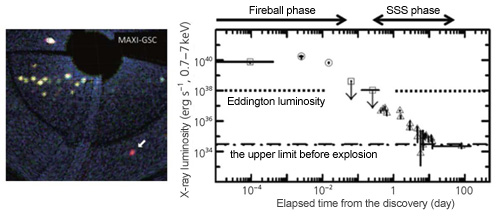TOP > Report & Column > The Forefront of Space Science > 2015 > The X-ray universe that MAXI was watching for five years
![]()

The discovery of the black hole 12 black holes have been discovered in the world since 2009, and MAXI has discovered six of them and itís the world's most. The half of the six had conventional light curves which quickly appeared in a few days and exponentially attenuated in about 100 days, they also appeared during Ginga era, and they were studied in detail investigation. The other black holes reached their peak brightness in the early phase and were discovered by MAXI for the first time (March 2010 issue). Although reaching the peak brightness is a common phenomenon for the accretion of Roche lobe overflow, itís unclear whether it is related to the instability of the accretion disk the X-ray outburst. In addition, the many of those found by MAXI look dark. Estimating the distance based on the brightness when the accretion disk is shifted in the spectrum state, we found out that MAXI detected also those emerged in the spiral arm on the other side beyond the center of the Galaxy (Figure 2). MAXI can observe more than the half of our galaxy.
The soft-X-ray flash ďMAXI J0158-744ĀE On November 11, 2011, MAXI found the soft X-ray transient object ďMAXI J0158-744ĀE on the eastern edge of the Small Magellanic Cloud (Fig. 3 left). This celestial object is automatically discovered by Novasearch, and that was automatically reported all over the world in just 47 seconds after it occurred. Since this celestial object is ďred and brightĀE we can see that X-rays is 4 keV or less and that it sparkles as bright as Crab Nebula. This is a big problem. Since the Small Magellanic Cloud is present at the location which is 30 times more distant than Crab Nebula, it is 900 times brighter than Crab Nebula in fact. It was more than 100 of than the Eddington limit of a solar mass. This X-ray was the soft-X-ray flash of the "fireball phase" immediately after the nova explosion ,which it was the first time to catch in astronomical history. Soft X-ray radiation, which is in the period of a super soft X-ray source (SSS) and appears at the termination period after nova explosion, was observed by Swift satellite (Fig. 3 right). This was earlier than predictions of the theoretical model, and it meant the mass of white dwarf is close to the theoretical maximum mass "Chandrasekhar limit (1.4 times the solar mass)". In the second scan in 1300 seconds by SSC, strong bright line of neon was detected in the energy spectrum. The neon atom was highly ionized and leaving only two electrons. In the first place, it is rare that an element bright line is observed in the spectrum of transient object. This white dwarf was made of O-Ne-Mg, so-called "heavyweight", it seems that neon on the white dwarf was blown off due to the explosion. In order to explain the strong neon bright lines which is contrary to common sense, a new theoretical model has been proposed.
New phenomenon that we haven't even thought of Unlike the star shining by visible light, many of the celestial bodies that emit X-rays vary greatly, appear and disappear suddenly. There are still many mysteries about the causes of radiation mechanism and the variation of these X-ray sources. In addition to the soft X-ray flash, the new phenomena, which we have not even thought of, was observed. One of those was a tidal destruction phenomenon of a star to massive black hole in the center of the galaxy. A strong X-ray was suddenly radiated from the galaxy which lay approximately 7500 light-years from Earth and had been quiet until then, and that had followed a few days violently. We comprehensively analyzed continuous MAXI observation before brightening and detailed Swift observation after brightening, and we found out that it was the moment that a star was destroyed by the huge black hole in the center of the galaxy (October 2011 issue). This outcome was mentioned as one of the first-rate outcomes ISS accomplished. The other was Super X-ray burst in the Low Mass X-ray Binary (LMXB.) The X-ray burst which conventionally continues for about 100 seconds is a fusion explosion that a lodgment causes on neutron stars. In contrast, the super burst continues for several hours and releases centuple energy. It isn't clear about the reason why there are 2 kinds and about what is burning and where itís burning. 8 examples out of 25 in recorded history were observed with MAXI because it matched the time scale of MAXI observation. There was also one which was observed more than once from the same celestial body, and it offers basic data such as repeating period and accreting mass.
|
||||||||||






